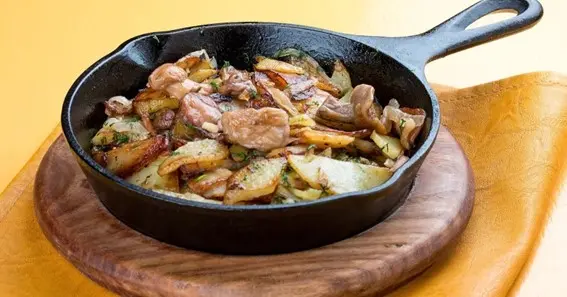What is a skillet? A skillet is a cooking pan with a broad, flat bottom and sloped sides, ideal for sautéing and stir-frying. A pan’s form and a bigger cooking surface make it helpful kitchen equipment. Skillets have flared sides, unlike splatter pans. This enables you to sauté or stir-fry swiftly. It suits chefs and home cooks because it works with several cooking methods. In this article we discuss about what is a skillet and more about it.
What is a Skillet?
A skillet is a cooking pan with a broad, flat bottom and sloped sides, ideal for sautéing and stir-frying. Skillets are cooking tools that have a wide, flat bottom and sloping edges. This design helps disperse and retain heat for uniform cooking. Skillets made of cast iron, stainless steel, aluminum, and copper cook better and last longer. Pan sizes are typically dependent on width. Most folks prefer 8–12 inches. Cooks may choose the pan size that works best for them, whether they’re cooking for one or the whole family. The pan you use impacts how effectively it cooks, how often you clean it, and how long it lasts.
Also Read N: What is Mulberry Silk? Origins of Mulberry Silk
Choosing and Maintaining Your Essential Kitchen Tool as a skillset

As we already discuss what is a skillet, always have a pan in the kitchen. Their wide, flat edges and slanted sides make sautéing and stir-frying effortless. Cast iron, stainless steel, and aluminum skillets work on many cooking surfaces. Their structure spreads heat and keeps it in the pan, ensuring consistent cooking. Learn about skillet characteristics and maintenance to pick the ideal one for your culinary requirements. This improves cooking accuracy and kitchen efficiency.
Design and Construction:
After readding about what is a skillet, it’s easy to tell a skillet from another pot because the bottom is wide and flat, and the sides spread outward and get bigger. This style makes it easy to turn, flip, and toss the food, which speeds up the cooking process. There are many forms and sizes of skillets. Different ones have sides that are flat or slightly curved.
Versatility in Cooking:
One great thing about skillets is that they let you move food around in the kitchen. You can burn them, fry them, sauté them, stir-fry them, braise them, and even bake with them. Since they can go from the stove to the oven, skillets are great for cooking a wide range of foods, such as steaks, burgers, frittatas, and sweets.
Heat Distribution and Retention:
How well a pan holds and spreads heat is an important part of its design. Cast iron and other metals are great at keeping heat in, so the temperature stays the same while you cook. A lot of people love metal and stainless steel skillets because they spread heat out evenly and let you carefully control the temperature of your food.
Seasoning and Maintenance:
You season iron by putting oil on the cooking surface to make a natural non-stick layer and keep it from rusting. The pan will work better and last longer if you season it. Also, food will stick less often over time. Take care of your metal or stainless steel skillets daily if you want them to look good and work well.
Handle Design and Ergonomics:
It’s easy to hold and move a skillet because its sides are long and bendy. Some skillets have an extra handle that goes across from the main handle to make them easier to move and fill. Most handles are made of heat-resistant materials, like rubber, stainless steel, or plastic that don’t melt when heated. As you know that what is a skillet, this makes them safe to use while cooking.
Compatibility with Cooking Surfaces:
You can use a pan on many types of cooktops, such as gas, electric, ceramic, or induction. On an induction stove, you should only use pans made of magnetic materials, such as cast iron or stainless steel. The food will cook faster because the heat will be able to move around.
Cleaning and Care Instructions:
If you take care of your pan and keep it in good shape, it will last longer. To keep the seasoning in place, clean cast iron skillets with hot water and a stiff brush. Don’t use soap on the pan because it can take away the natural oils. Not all skillets can go in the dishwasher.

Also Read P: What is Baby Corn? Facts About Baby Corn
Conclusion
In general, skillets are very useful cooking tools that people like because they are flexible, durable, and can cook food quickly and well for many different reasons. Buying a decent pan can help you experiment and cook better. It’s great for baking sweets, searing meat, and sautéing vegetables. Cooks may choose the ideal skillet for their cooking style and kitchen needs by understanding skillet styles, materials, and maintenance. In above we discuss about what is a skillet and explore more about it.
FAQ
Are skillets and frying pans the same?
Pancake pans and skillets are alike, but skillets have thicker sides that flare outward, which makes it easier to mix and stir things.
Which material is best for a skillet?
Which things are best depends on how you cook. If you want to cook with less fat, cast iron is a great choice because it keeps heat in well. Stainless steel lasts a long time and heats evenly.
How do I season a cast iron skillet?
Spread a little butter or vegetable oil over the whole cooking surface of a cast iron pan to make it ready to use. Then put it in a hot oven upside down and bake for about an hour.
Can skillets be used in the oven?
Of course, you can bake, roast, and broil in skillets made of oven-safe materials, like cast iron, stainless steel, and some non-stick finishes.
What size skillet is best for everyday use?
A 10 to 12-inch pan is usually the best for everyday cooking because it’s not too big and has enough room for a lot of different foods.
Sources:










